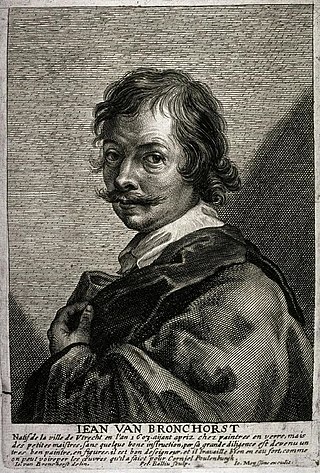Jacobus Clemens non Papa was a Netherlandish composer of the Renaissance based for most of his life in Flanders. He was a prolific composer in many of the current styles, and was especially famous for his polyphonic settings of the psalms in Dutch known as the Souterliedekens.

Jan Pieterszoon Sweelinck was a Dutch composer, organist, and pedagogue whose work straddled the end of the Renaissance and beginning of the Baroque eras. He was among the first major keyboard composers of Europe, and his work as a teacher helped establish the north German organ tradition.

Karel van Mander (I) or Carel van Mander I (May 1548 – 2 September 1606) was a Flemish painter, poet, art historian and art theoretician, who established himself in the Dutch Republic in the latter part of his life. He is mainly remembered as a biographer of Early Netherlandish painters and Northern Renaissance artists in his Schilder-boeck. As an artist and art theoretician he played a significant role in the spread and development of Northern Mannerism in the Dutch Republic.

Hans Leo Hassler was a German composer and organist of the late Renaissance and early Baroque eras, elder brother of less known composer Jakob Hassler. He was born in Nürnberg and died in Frankfurt am Main.

Hendrick de Keyser was a Dutch sculptor, merchant in Belgium bluestone, and architect who was instrumental in establishing a late Renaissance form of Mannerism changing into Baroque. Most of his works appeared in Amsterdam, some elsewhere in the Dutch Republic. He was the father of Pieter and Thomas de Keyser and Willem, and the uncle of Huybert de Keyser, who became his apprentices and all involved in building, decoration and architecture.
The Souterliedekens is a Dutch metrical psalter, published in 1540 in Antwerp, and which remained very popular throughout the century. The metrical rhyming psalms were, probably, arranged by a Utrecht nobleman: Willem van Zuylen van Nijevelt. For the melodies he used folksongs from the Low Countries. This publication has great value, because the publisher not only added the phrase 'sung to the tune of...' but also provided the actual music (melody) with the texts.

The Genevan Psalter, also known as the Huguenot Psalter, is a 1539 metrical psalter in French created under the supervision of John Calvin for liturgical use by the Reformed churches of the city of Geneva in the sixteenth century.

Cornelis de Bie was a Flemish rederijker, poet, jurist and minor politician from Lier. He is the author of about 64 works, mostly comedies. He is known internationally today for his biographical sketches of Flemish and Dutch painters in his Het Gulden Cabinet der Edel Vry Schilderconst, first printed in 1662.

Paul Siefert was a German composer and organist associated with the North German school.

Jan Gerritsz van Bronckhorst was a Dutch Golden Age painter and engraver. He is considered today to be a minor member of the Utrecht Caravaggisti.
Gerardus Mes or Gherardus was a Franco-Flemish composer.

Pieter Jacobsz Codde was a Dutch painter of genre works, guardroom scenes and portraits.

Cornelis de Man was a Dutch Golden Age painter.

Psalm 6 is the sixth psalm of the Book of Psalms, beginning in English in the King James Version: "O LORD, rebuke me not in thine anger, neither chasten me in thy hot displeasure". In Latin, it is known as "Domine ne in furore tuo arguas me". This penitential psalm is traditionally attributed to David.

Psalm 115 is the 115th psalm of the Book of Psalms, beginning in English in the King James Version: "Not unto us, O LORD, not unto us, but unto thy name give glory". It is part of the Egyptian Hallel sequence in the fifth division of the Book of Psalms.

Cornelis de Hooghe was a 16th-century engraver and mapmaker from the Northern Netherlands.

Psalmen Davids is a collection of sacred choral music, settings mostly of psalms in German by Heinrich Schütz, who had studied the Venetian polychoral style with Giovanni Gabrieli. Book 1 was printed in Dresden in 1619 as his Opus 2. It comprises 26 individual settings, which were assigned numbers 22 to 47 in the Schütz-Werke-Verzeichnis (SWV). Most of them use the text of a complete psalm in the translation by Martin Luther.

Philip Rubens (1574–1611), was a Flemish antiquarian, librarian and philologist from the Low Countries. He was the older brother of the prominent Flemish Baroque painter Peter Paul Rubens.

"An Wasserflüssen Babylon" is a Lutheran hymn by Wolfgang Dachstein, which was first published in Strasbourg in 1525. The text of the hymn is a paraphrase of Psalm 137. Its singing tune, which is the best known part of the hymn and Dachstein's best known melody, was popularised as the chorale tune of Paul Gerhardt's 17th-century Passion hymn "Ein Lämmlein geht und trägt die Schuld". With this hymn text, Dachstein's tune is included in the Protestant hymnal Evangelisches Gesangbuch.
Jauchzet dem Herren, alle Welt, SWV 36, is a choral setting of Psalm 100 in German for double choir by Heinrich Schütz. It is one of the Psalmen Davids, published in 1619. The psalm setting has been performed and recorded internationally.















